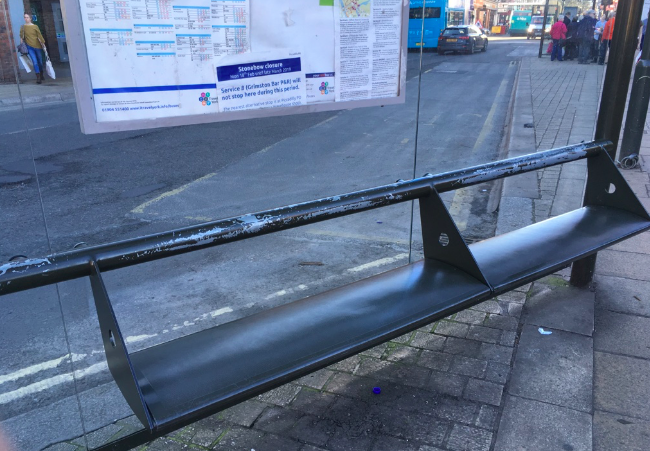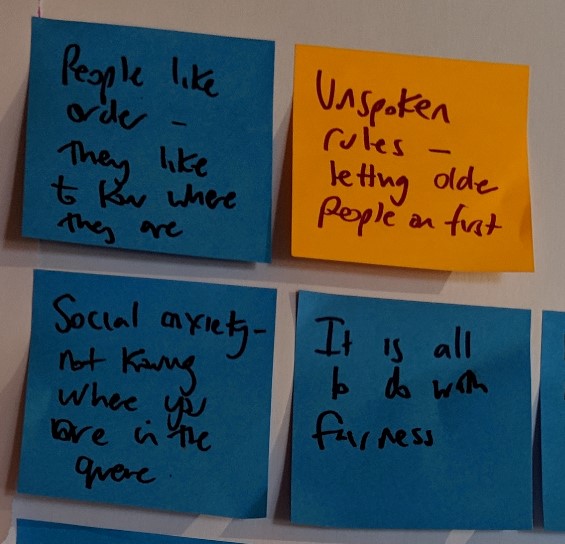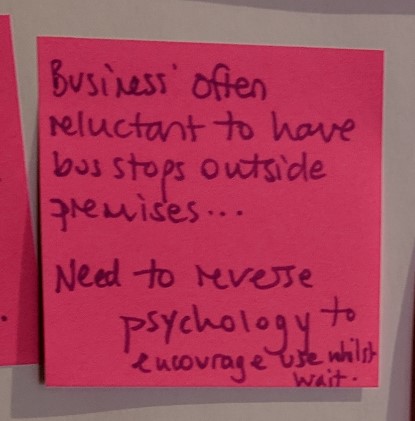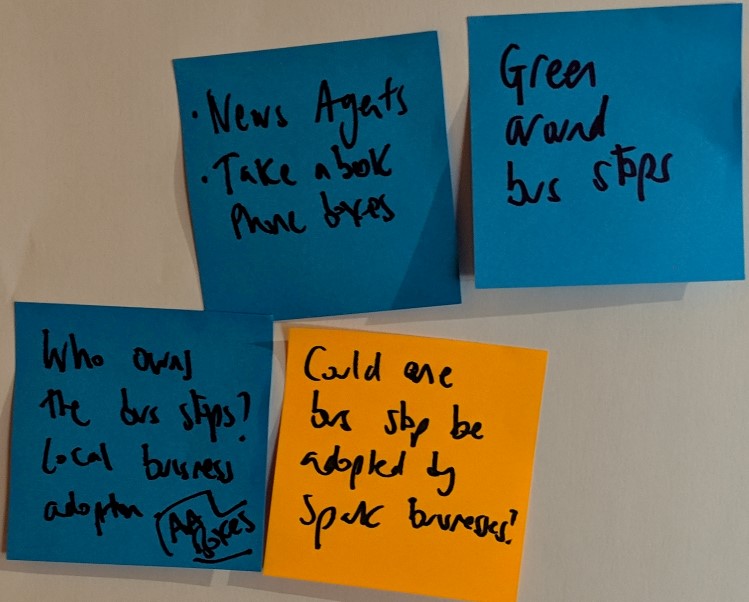
What would the best bus stop in York be like?
Drop-In / workshop 26th Feb 2019
Piccadilly serves many functions – even in its current state – and one of these if for the passage of buses and boarding them. Proposals as they stand include one bus stop on the section of Piccadilly south of Merchantgate – the section which is subject of our engagement and, ultimately, reshaping. We wanted to consider the apparently humble bus stop in this context – in a changing public realm, what might a bus stop be?
Where do we start?
We started with a walk and a look at the bus stops at the upper end of Piccadilly. These are the Norman Foster-designed standard shelters which are common in central York, largely owned and managed by J C Decaux and with large advertising hoardings doubling as windbreaks. They are functional within limits; they very much face one way with a sheltered side and an open side, and seating is linear. (In rare cases this rulebook has been bent – the Museum Street L-shaped seating under shelter came about when the council bought shelters themselves to create the unconventional layout). Some face the road, some face the back of the footway, some are set at an angle at “chevron”-arranged bus stops. If you want anything extra at your bus stop it basically is a separate installation – touch-screen info points and rubbish bins sit in-between the shelters.
Where there are problems, they’re not, generally, about the shelters themselves – they result from lack of space causing conflicts between waiting passengers and other pedestrians, or they’re where advertising hoardings are installed where they block the view of approaching buses. But even where they function reasonably smoothly, they seem a missed opportunity and leave questions unanswered.
Ambiguity and certainty
 We talked to bus users and shared stories. Buses that overshoot the shelter and throw the queue into confusion. The subtle social codes of the queue – how does the able-bodied teen see the elderly or wheelchair-bound, or those surrounded by luggage? How are attitudes shaped by scarcity of supply – a group of waiting people who don’t know if there will be space on the bus for them, and in some cases don’t know when it will arrive? Is queuing essential – we don’t do it in pubs, nor on railway platforms?
We talked to bus users and shared stories. Buses that overshoot the shelter and throw the queue into confusion. The subtle social codes of the queue – how does the able-bodied teen see the elderly or wheelchair-bound, or those surrounded by luggage? How are attitudes shaped by scarcity of supply – a group of waiting people who don’t know if there will be space on the bus for them, and in some cases don’t know when it will arrive? Is queuing essential – we don’t do it in pubs, nor on railway platforms?
The broader context
One issue that quickly became clear is that the “ownership” of bus stops and shelters merits consideration. They are associated solely with bus transport and the users of bus transport. Adjacent shops don’t generally like them – people awaiting buses are seen as inconvenient; an obstacle for shop customers rather than potentially *being* the shop customers.
 But this is a conventional view originating from streets where bus stops are squeezed into existing space – footways often become footways *and* bus waiting spaces. In Piccadilly we have the opportunity to create a space where people can move and linger without conflict. How do bus stops fit within this different context, where many people are lingering and some are lingering for a bus?
But this is a conventional view originating from streets where bus stops are squeezed into existing space – footways often become footways *and* bus waiting spaces. In Piccadilly we have the opportunity to create a space where people can move and linger without conflict. How do bus stops fit within this different context, where many people are lingering and some are lingering for a bus?
The issue of “ownership” becomes more open to debate too. In a space where independent businesses want to engage with people who pass and linger, where is the sense in having a standard bus shelter maintained by a distant corporation, and advertising the same products that feature on identical shelters in Penzance or Edinburgh? Can local businesses take ownership and use the bus stop and shelter as a positive feature of their environment – a chance to make people feel more comfortable about spending time there? In some locations adjacent buildings become part of the stop – arches and overhangs become shelter – so can the reverse apply and the stop and shelter become an extension of the surrounding environment? Could information screens or noticeboards tell local stories? in fact, could there be books?

The detail stuff
Aside from this wide-angle consideration, it’s worth also focusing in on some detail too. part of the uncertainty of bus travel is to do with timing information – someone described the “faith-based approach to bus use”, and certainly improving timing information is a major component of improving the experience of bus travel. Reliable timing knowledge benefits more than just the traveller though – a bus user who knows their bus is due in ten minutes and can see a coffee vendor across the footway is more likely to become a local customer. A creative business seeking to engage with passers-by stands a better chance of engaging with a waiting bus passenger who isn’t staring anxiously into the distance.
 Bus information is handled differently to other transport information, largely due to the different context of distributed bus tops, rather than a station or airport. There is rarely centralised information, and never audio information – turn up at the wrong stop (as one woman did while we talked with her) and you’ll receive no helpful information at all.
Bus information is handled differently to other transport information, largely due to the different context of distributed bus tops, rather than a station or airport. There is rarely centralised information, and never audio information – turn up at the wrong stop (as one woman did while we talked with her) and you’ll receive no helpful information at all.
This leads helpfully back out to broader issues. Bus travel sometimes feels shaped around a core of experienced users – those who know not just which stop to be at, but what time to arrive and exactly where to stand for best chance of success. How can the design of stops open up bus travel? It’s potentially a great part of a “non-car” world of multi-modal travel – bus / foot / cycle – but it needs to help facilitate this with clearer information and, perhaps, integrated cycle parking close by.
The best bus stop
By the end of the drop-in it was clear that there was more to a bus stop than we’d first thought and that incorporating a bus stop into a re-shaped Piccadilly was an interesting opportunity – a chance to provide for and promote bus travel as a positive use of street space. This requires enough space, so the bus stop becomes part of the “lingering” area of the public realm. It requires connection with surrounding businesses. It requires the stop to reconcile the need for clarity around some issues with a context of flexible, informal use. But get it right – and the affection for the still-relatively-conventional L-shaped Museum Street stop shows – and people notice.